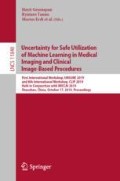Abstract
State of the art machine learning methods need huge amounts of data with unambiguous annotations for their training. In the context of medical imaging this is, in general, a very difficult task due to limited access to clinical data, the time required for manual annotations and variability across experts. Simulated data could serve for data augmentation provided that its appearance was comparable to the actual appearance of intra-operative acquisitions. Generative Adversarial Networks (GANs) are a powerful tool for artistic style transfer, but lack a criteria for selecting epochs ensuring also preservation of intra-operative content.
We propose a multi-objective optimization strategy for a selection of cycleGAN epochs ensuring a mapping between virtual images and the intra-operative domain preserving anatomical content. Our approach has been applied to simulate intra-operative bronchoscopic videos and chest CT scans from virtual sketches generated using simple graphical primitives.
Access this chapter
Tax calculation will be finalised at checkout
Purchases are for personal use only
References
Krizhevsky, A., Sutskever, I., Hinton, G.E.: Imagenet classification with deep convolutional neural networks. In: Advances in Neural Information Processing Systems, pp. 1097–1105 (2012)
Johnson, J., Alahi, A., Fei-Fei, L.: Perceptual losses for real-time style transfer and super-resolution. In: Leibe, B., Matas, J., Sebe, N., Welling, M. (eds.) ECCV 2016. LNCS, vol. 9906, pp. 694–711. Springer, Cham (2016). https://doi.org/10.1007/978-3-319-46475-6_43
Zhu, J.-Y., Park, T., Isola, P., Efros, A.A.: Unpaired image-to-image translation using cycle-consistent adversarial networks. arXiv preprint arXiv:1703.10593 (2017)
Radford, A., Metz, L., Chintala, S.: Unsupervised representation learning with deep convolutional generative adversarial networks. arXiv preprint arXiv:1511.06434 (2015)
Frid-Adar, M., Klang, E., Amitai, M., Goldberger, J., Greenspan, H.: Synthetic data augmentation using GAN for improved liver lesion classification. In: 2018 IEEE 15th International Symposium on Biomedical Imaging (ISBI 2018), pp. 289–293. IEEE (2018)
Shin, H.-C., et al.: Medical image synthesis for data augmentation and anonymization using generative adversarial networks. In: Gooya, A., Goksel, O., Oguz, I., Burgos, N. (eds.) SASHIMI 2018. LNCS, vol. 11037, pp. 1–11. Springer, Cham (2018). https://doi.org/10.1007/978-3-030-00536-8_1
Frid-Adar, M., Diamant, I., Klang, E., Amitai, M., Goldberger, J., Greenspan, H.: Gan-based synthetic medical image augmentation for increased CNN performance in liver lesion classification. Neurocomputing 321, 321–331 (2018)
Calimeri, F., Marzullo, A., Stamile, C., Terracina, G.: Biomedical data augmentation using generative adversarial neural networks. In: Lintas, A., Rovetta, S., Verschure, P.F.M.J., Villa, A.E.P. (eds.) ICANN 2017. LNCS, vol. 10614, pp. 626–634. Springer, Cham (2017). https://doi.org/10.1007/978-3-319-68612-7_71
Goodfellow, I., Bengio, Y., Courville, A.: Deep Learning. MIT Press, Cambridge (2016)
Miettinen, K.: Nonlinear Multiobjective Optimization, vol. 12. Springer, New York (2012). https://doi.org/10.1007/978-1-4615-5563-6
Acknowledgments
The research leading to these results has received funding from the European Union’s Horizon 2020 research and innovation programme under the Marie Sklodowska-Curie grant agreement No 712949 (TECNIOspring PLUS) and from the Agency for Business Competitiveness of the Government of Catalonia. Work supported by Spanish Projects FIS-G64384969, Generalitat de Catalunya, 2017-SGR-1624 and CERCA-Programme. D. Gil is a Serra Hunter fellow. The Titan X Pascal used for this research was donated by the NVIDIA Corporation.
Author information
Authors and Affiliations
Corresponding author
Editor information
Editors and Affiliations
Rights and permissions
Copyright information
© 2019 Springer Nature Switzerland AG
About this paper
Cite this paper
Gil, D., Esteban-Lansaque, A., Stefaniga, S., Gaianu, M., Sanchez, C. (2019). Data Augmentation from Sketch. In: Greenspan, H., et al. Uncertainty for Safe Utilization of Machine Learning in Medical Imaging and Clinical Image-Based Procedures. CLIP UNSURE 2019 2019. Lecture Notes in Computer Science(), vol 11840. Springer, Cham. https://doi.org/10.1007/978-3-030-32689-0_16
Download citation
DOI: https://doi.org/10.1007/978-3-030-32689-0_16
Published:
Publisher Name: Springer, Cham
Print ISBN: 978-3-030-32688-3
Online ISBN: 978-3-030-32689-0
eBook Packages: Computer ScienceComputer Science (R0)


